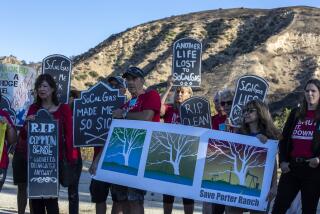Go Easy on the Gas
- Share via
Liquefied natural gas could play an important role in a balanced federal energy policy. Natural gas is cleaner-burning than its cousin fossil fuels, oil and coal. But in order to be shipped to the United States from foreign sources, it has to be cooled to minus 260 degrees, shipped in liquid form and delivered to local terminals.
From there, it could be piped as a gas to homes and businesses for cooking, heating and power generation. Refined in its compressed form, it is a clean fuel for truck and bus fleets. That’s good for energy consumers and possibly the state’s air quality. But few people want gas terminals in their backyards. Though its safety record in Europe and Asia is good, the concentrated fuel could set off a massive explosion if it were to escape and ignite. No one seems sure how broad the vapor cloud would be, but recent environmental reports have indicated more than a mile. Other estimates are larger.
An accident is highly unlikely, but at least two solid studies have shown that the terminals are vulnerable to terrorist attack. Yet in its rush to aid the energy industry, the Senate voted last week to deny states any power in deciding where terminals should be located -- either onshore or in state waters -- and to give that authority to the Federal Energy Regulatory Commission.
That’s nutty, considering that the governor still has veto power over terminals in federal waters, more than three miles offshore. Shouldn’t the governor have at least equal power on land and in state waters?
The Senate vote, sought by President Bush, would overrule developing state legislation. A bill by state Sen. Joe Simitian (D-Palo Alto) would have the state decide where LNG terminals should be located.
Both state and federal governments should play a role in these decisions. Simitian’s bill would take into account California’s needs for LNG. But energy demand crosses state boundaries; a bigger viewpoint is needed. At the same time, California and other coastal states would bear the brunt of any catastrophe and should have a strong voice in the matter. That’s how it works in federal waters: The Coast Guard and Federal Maritime Administration have primary authority but have to work with the state.
Gov. Arnold Schwarzenegger on Thursday voiced support for a terminal proposed in federal waters 14 miles off Oxnard. There are three other proposals for the state, one at the Long Beach port, easily the most troubling site. The port is within a couple miles of heavily populated areas and a catastrophic accident there could cripple vital shipping.
Though the governor favors what’s probably the safest site, an issue this important calls for a more studied approach. Safety should not take a back seat to federal regulators’ eagerness to build terminals.
More to Read
Get the L.A. Times Politics newsletter
Deeply reported insights into legislation, politics and policy from Sacramento, Washington and beyond. In your inbox three times per week.
You may occasionally receive promotional content from the Los Angeles Times.










